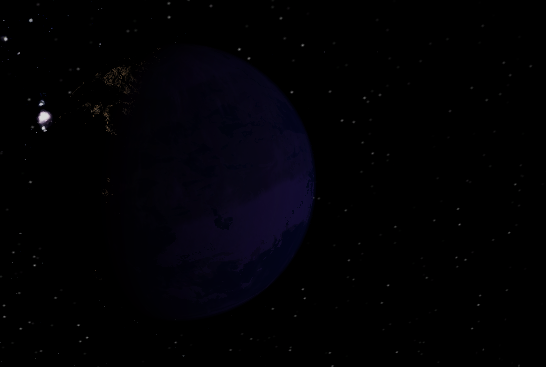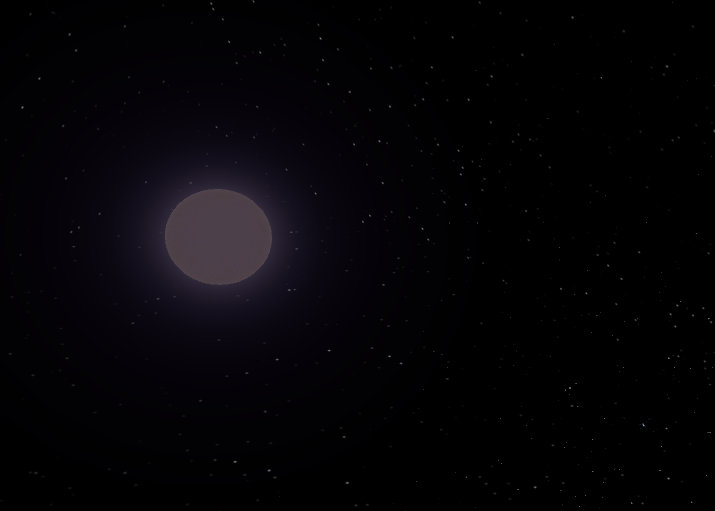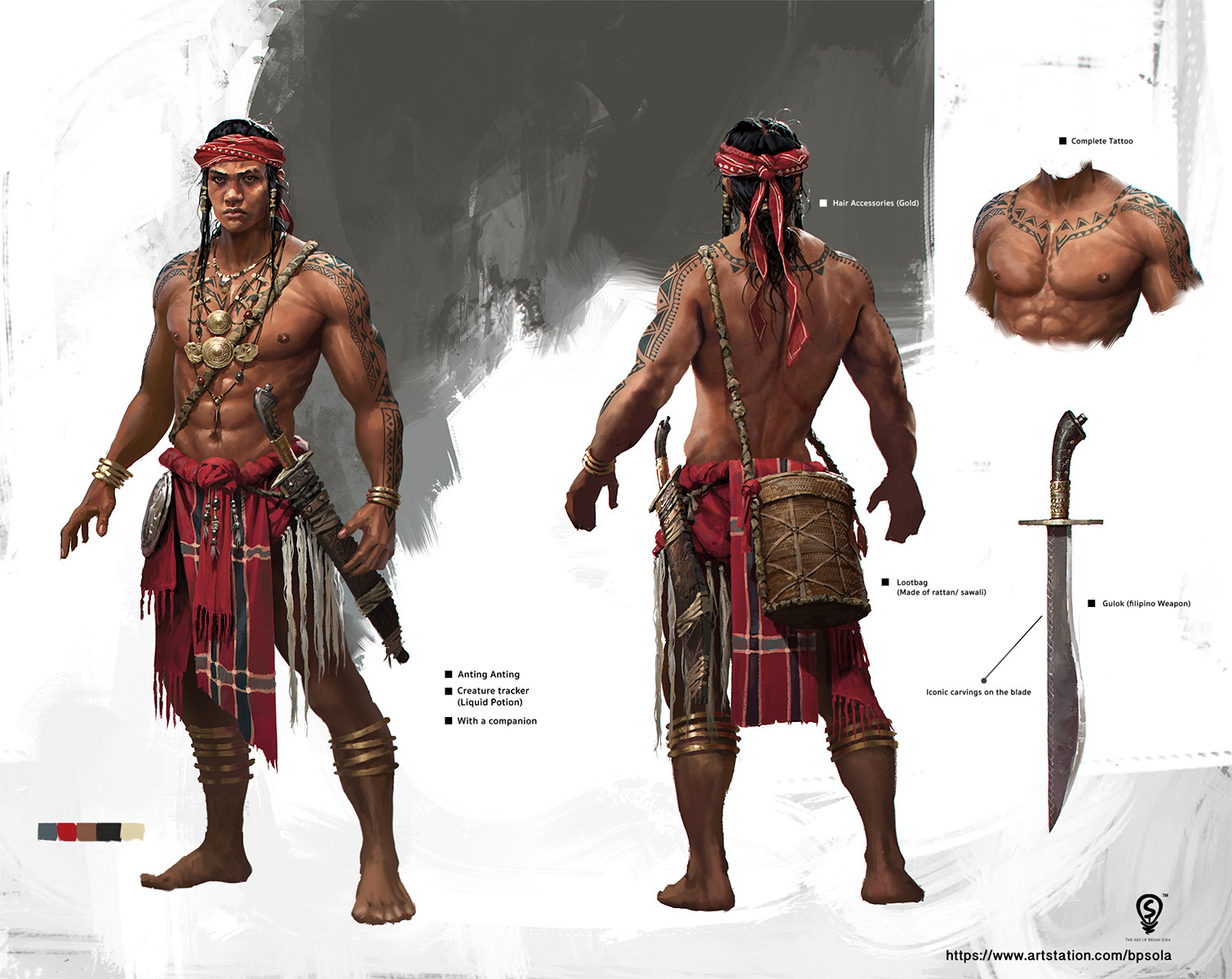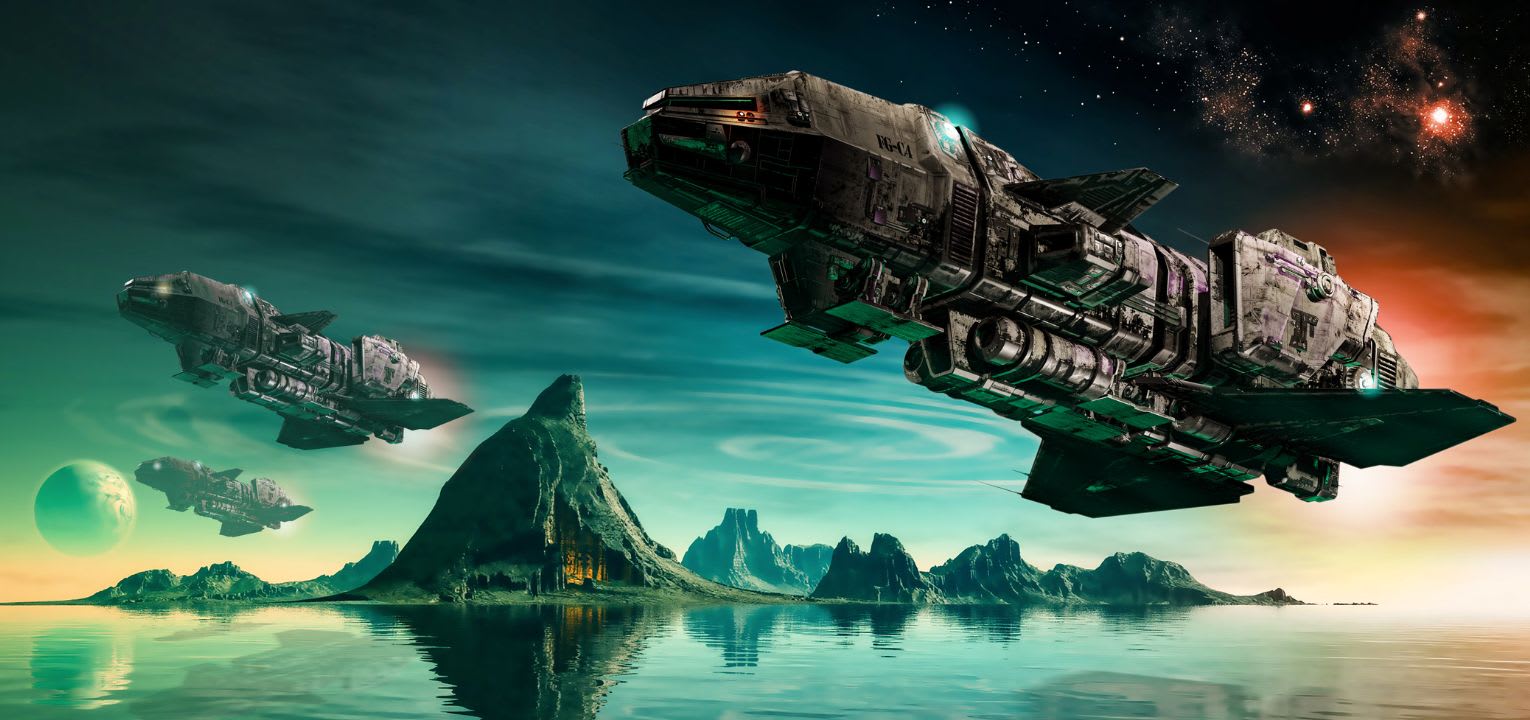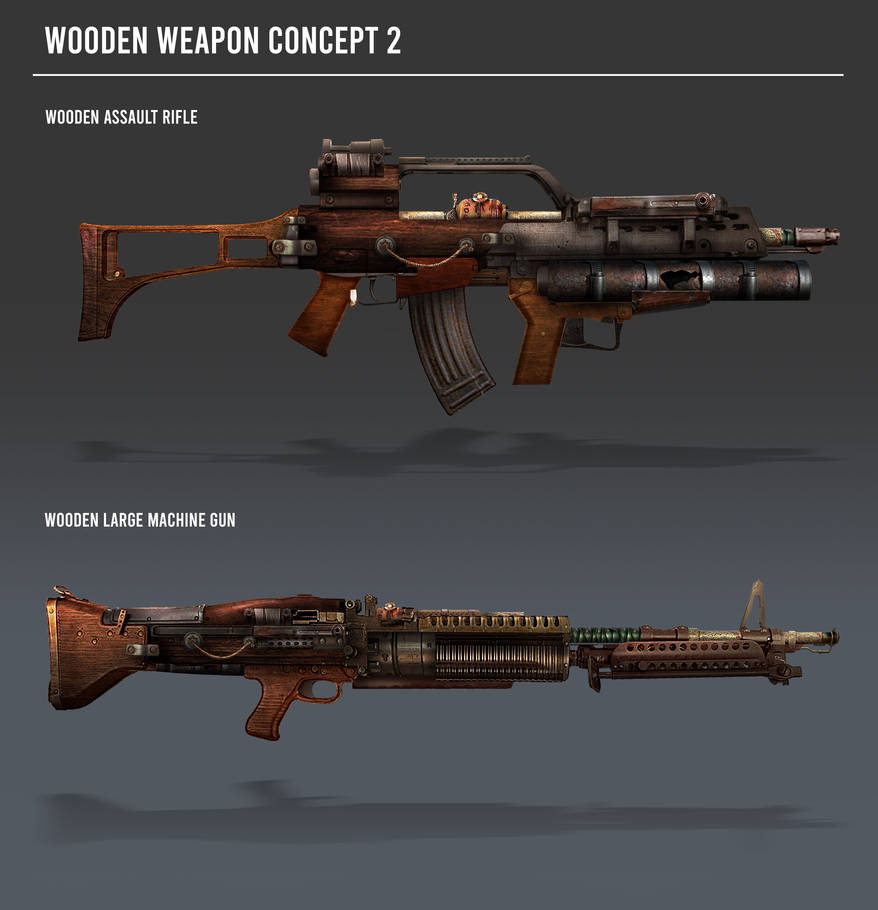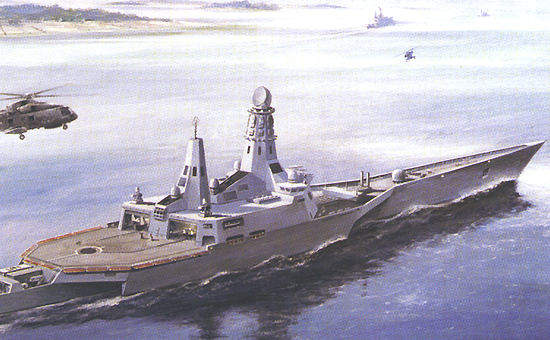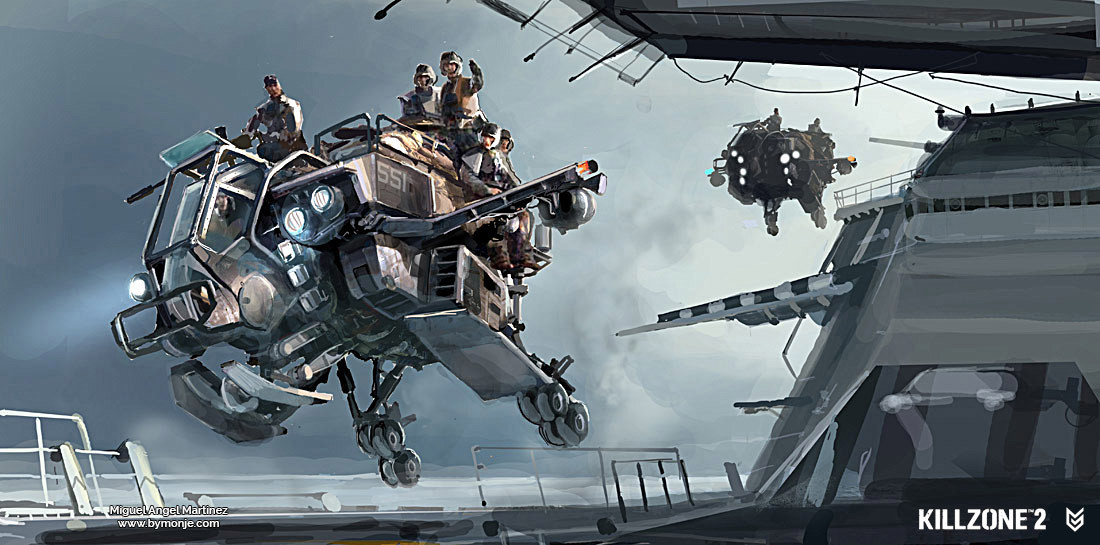The Gilt Division

"Life is of Nature; Nature can be Rewritten"
Government Form:
Fragmented Megacorps
Demographics:
By Location:
Gilt: 70%
Argent: 30%
In Space (on mining colonies, asteroids, or the Rainbow): <1%
___
By Corporate Loyalty*:
Oldwell Conglomerate: 30%
Everett Corp: 28%
Earnest, Smithers and Black (EBS): 18%
NeoTerra: 7%
Xederox: 7%
Hei Technology: 6%
Sertron: 4%
*These corporations together are called "the Seven," and make up the governance of the Gilt system. The first three are sometimes called "the Top Three," and will have the most influence when it comes to Gilt's dealings with other nations. The "Little Four" that follow them should be less important where other nations are concerned.
___
By Race:
Human: 66%
Stamp: 30%
Syms*: 4%
*As one sym mind can occupy hundreds or thousands of bodies simultaneously, or none at all, the sym population is here calculated based on the number of physical bodies currently in use. No attempt is made to guess how many unique sym minds exist, but the number is probably only a few ten-thousand.

Could you tell she's not human?
There are other words for stamps: they're called clones and cyborgs on the streets, "resequenced individuals" in corporate papers. But "stamp" works for most people; it's not too rude, and it's clear who you're talking about. The people with barcodes tattooed onto their wrists and backs, like a stamp on product at the superstore. The people who are corporate property.
They were built that way; a stamp is anyone created in a gene factory, a streamlined laboratory that grows and sells clones. They were not born. They do not reproduce. Some of them look like humans (some of them most definitely do not), but in a genetic sense, they're not very human at all. They're synthetic people, part organic and part cybernetic, built for specific jobs. Some are bodyguards, with skin like a rhinoceros and nutrasteel bones, and a mind about as trusting of strangers as a paranoid crocodile. Some are pilots, with a preternatural sense of orientation and a neural link connecting them directly into the ship they fly.
But most are just waitresses, cooks, bureaucrats and tech support and janitors, doing low-class jobs, freeing up the human population for more fulfilling work.
They don't typically mind this; by-and-large, stamps are also created to have an intrinsic desire to be helpful. They want to serve a purpose. There may be some dog DNA in there. This works in tandem with cybernetic components of the stamp that keep them focused on fulfilling their purposes. Since their creation, the existence has greatly changed the Gilt economy, and they're part of why most Terrans today have it so much easier and richer than their forebearers. Some in the Division consider this their greatest accomplishment, the crowning glory, but others wonder if they'd still make it a week without their custom-tailored slaves.

Somewhere inside that metal skull, there's memories of a childhood and a sinking feeling of loss
Giltians believes strongly in only two things. One: the importance of humanity, and two: profit.
The order of these two things is debatable.
With that in mind, it was never likely that corporate scientists would spend time painstakingly. slowly working on advanced AI. The benefits are obvious, but the start-up cost for such a venture is just too high. And, besides, who could trust an AI? An unknowable mind lives behind that screen, as alien to you as water to electric fire. You have no part in it and it has no part in you.
So it was a good day for Gilt when the first sym was created. Their name comes from "simulation," and they are near-exact copies of a human brain, translated into a digital format. This is what they simulate: humanity. An AI that, perhaps is not human, perhaps never was, but thinks of itself as one just as much as you do.
But it should be clear, syms aren't humans who ascended to be silicone. This is not quite like a human becoming an AI. It's more like an AI that's based on a human personality. A human gets into a machine and has his brain scanned, and then his traits and memories and knowledge and everything get stored as a sym. But then the human stands up out of the machine, and continues his life and eventually dies of old age. He doesn't become the AI. There are few on Gilt who believe he does.
The sym and the human exist simultaneously, in fact, and in a funny way, both would probably tell you that they're the original.
But then the sym gets put to work. Like a stamp, they are not free humans, but corporate property, owned by the company that paid for their creation. This is the way Gilt preserves people with truly useful skillsets. If someone is an abnormally skilled pilot or scientist or anything else, the Division will approach them and offer to buy a sym of their mind.
They pay a good bit, since it is a selling of 100% of your personal information, down to your most private thoughts and feelings, to a cold corporation. But the person does gets paid, and gets to continue their life, and an exact copy of them spends forever carrying out their best work.
___
Population:
2.4 Billion
---
2.4 Billion
---
Planet Name and Description:
Unlike many colonies, the colony ship sent to the Gilt system had two habitable worlds to chose from. The downside: neither was an ideal choice.

Scorching heat and thin air; habi-pods like these were dropped down first, to protect the colonists inside.
"A world of shining opportunity! The little planet of Gilt is full of clean air and plenty of warm, open space, where a pleasantly Earth-like gravity will keep your step light and your mood friendly. The best part? It's bursting with treasure. Gold and rare minerals under the soft Gilt sands. Come and find your fortune!"
-an advertisement for the Gilt/Argent colony ship
Gilt is world smaller than Earth, but with a slightly higher gravity and a thinner atmosphere. It is a little closer to its sun (also a yellow dwarf), which works with the thin atmosphere to keep the place hot at noon and freezing at midnight. Like Mars, its believed that much of the planet used to have water, possibly even oceans, but some unknown and unknowable cataclysm of the past dried them out. Fish fossils are found in low desert dips.
It has life. Or, had life. It had unique life, until the Gilt Division did what they called "a rewriting of the natural ecosystem," and what others call a crime against nature.
But more on that in the History section.
Nowadays, the Gilt ecosystem is similar to Earth's, and most of the local species are a familiar kind. The equatorial "Desert Belt" has Middle-Eastern species like camels and palm trees in some regions, and American breeds like cacti or rattlesnakes living in other areas. You can find Africa-esque savannahs in the more fertile spots and up near the poles, instead of artic cold, only cool forests mirroring Northern Europe or North America. The air and soil of the world, too, has been terraformed into just a drier, hotter reflection of Old Earth.
Gilt has most of the heavy industry of the Division, most of the economic power too. Especially on the equator, shining megacities dot the Desert Belt like little jewels, sacrificing comfort for access to the best resources and easy solar power.
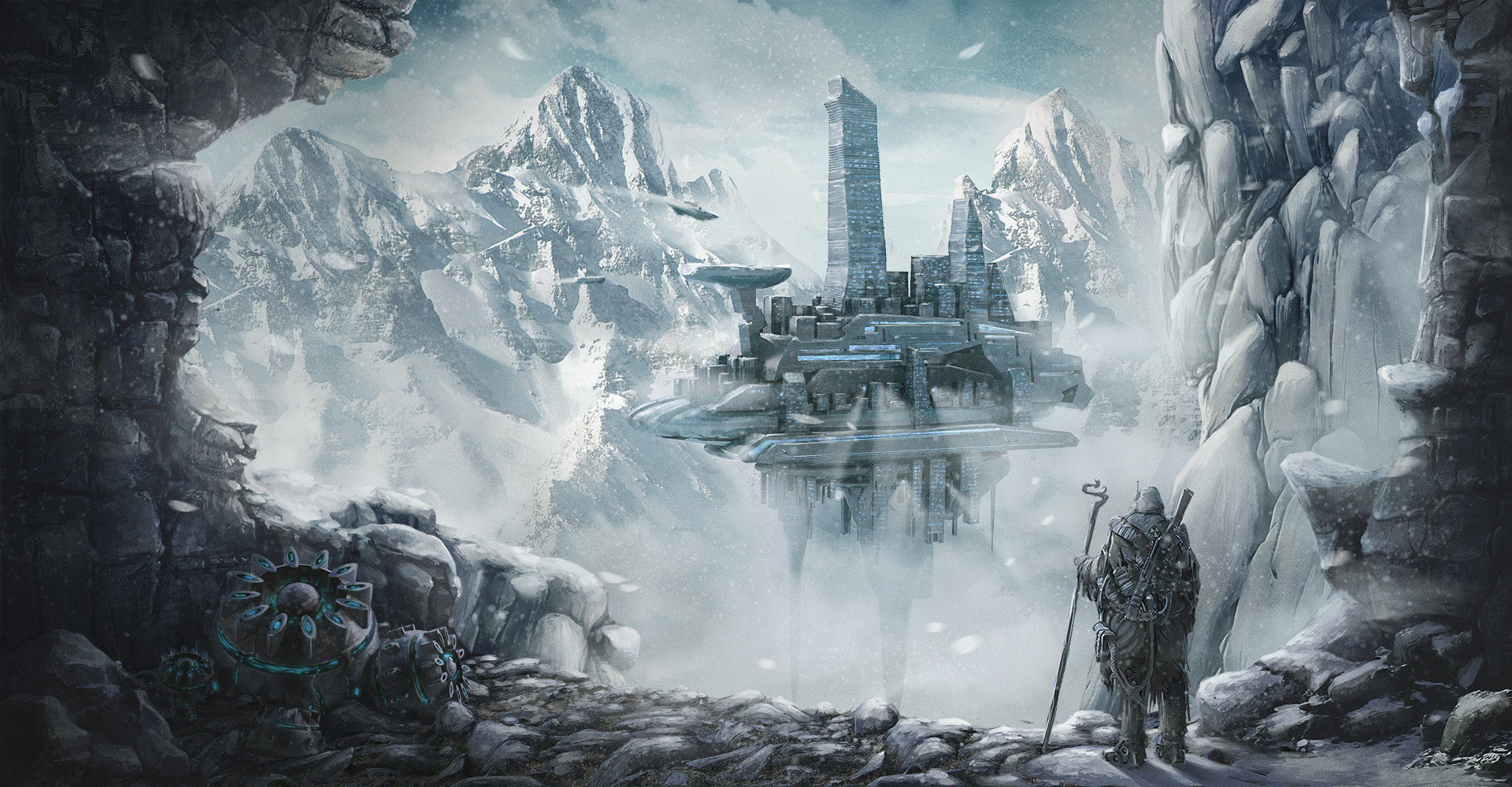
A compact outpost hidden in the mountains; the cold is not the greatest threat here.
"Be an Explorer: Argent is a cool, wild world of untapped and untamed wilds. But never to fear, our patented Habi-Pods™ will keep your warm and safe while you make this land your own. What will you discover?"
-an advertisement for the Gilt/Argent colony ship
The smaller and colder of the two sisters, Argent is named after an old word for silver- more for its color than its composition. Unlike Gilt, its not much for mineral resources. The atmosphere is more akin to Earth but the lightweight gravity is less so. The biodiversity was the real promise. Unlike Earth, where the truly cold places are barren, snowy Argent is bursting with more life than an Amazon jungle, from the tundra poles to the boreal midregions. The advertisements weren't fluffing it: strange life really does wait around every corner, and lurk under every stone.
This is why nobody wants to live there.
Its not just that the life there is plentiful and strange. It's that, on some level, it's all one thing; all the life on this world cooperates and shares information, even as it competes. This is not metaphor. Scientist believe that Argent may have some kind of primitive, wild hivemind that stretches across every animal and every plant and every of the other, weirder things that defy categorization. The hive's thoughts are like its world: glacial and slow-moving. It has barely noticed the presence of humanity yet, but what it has seen, it does not like. We are an invader.
So, Argent is the less colonized world. Unlike Gilt, no "rewritting" was made of its biosphere, the Division not wanting to ruin the world's greatest attribute. Cities here have to be hidden in the purest tundra, or if they dare to live in the more lifelike regions, fortified against the intruders. They depend heavily on Gilt for economic support. They do, however, serve as a kind of academic center, as their are more universities, labs and gene factories here than anywhere else. People think it may be owing to the crisp air, but people living on Argent often have sudden bursts of inspiration.
For what it's worth, the little bit of food that can be grown here is unusually delicious.

A city in the void- a shining, technicolor beacon of Gilt values.
While Gilt was being rewritten and Argent was not yet cleared for colonization, there were several awkward years where the Giltian colony ship was orbiting around two potential worlds, but not able to set foot on either one. Claustrophobia was setting in. Don't misunderstand- it was a big ship, one of the largest, with room for 500,000 bodies. The problem is that human bodies do not much like being trapped in close space, fighting for room, breathing recycled air that tastes much like chemicals and drinking water that may have been your neighbor's yesterday urine. Human bodies used to being rich like it even less.
Keeping people from madness, the corporations needed to make space. The funding of a dozen corporations had given the vessel access to on-board industry and fabrication units, originally meant to keep the affluent residents living almost-luxuriously while en route. You need a new dress, by tonight? The ship would make it for you. But, harvesting rich minerals from the Gilt asteroid belt, it became possible to reprogram the units to instead create materials for building new modules, which could be added to the ship gradually. They built new rooms, like private kitchens and luxury apartments. Then, theaters, gyms, dancefloors, restaurants.
Years passed, the desert planet's native life withering, the ship overhead growing and bloating out, a hungry parasite latched to Gilt.
When the all-clear signal for colonization came, the vessel was 70% larger than it had began. It was spacious and rich within, and not everyone wanted to trade that for a harsh life in a desert. Many of the colonists (especially the wealthier and older) stayed onboard, and aided the colonization efforts as they could from above.
Hundreds of years passed, and while expansion slowed, it could never altogether stop. The vessel was renamed the Rainbow after a beautification effort in Yr. 180 After-Earth, funded by an eccentric billionaire. Eccentrics often live on the Rainbow. Originally built for five-hundred-thousand, the ship now contains upwards of four million. If you don't mind elbowing through the crowd sometimes, it is probably the richest place in the system. No longer a colony ship; a city-ship. Their very own Atlantis.
History:
The Giltian colony ship came screaming into the Gilt system, the Gateway collapsing behind them. Five-hundred-thousand people gripped their chairs in knuckles white with panic. They had left Earth at the last possible moment, they all realized then. It might be said that they were the very last ship. Barely did their tail end leave the shimmering portal before it disappeared behind them, and were the Gateway was, only the dark of space.
And, below, two habitable planets. Not one: the corporations that funded this final colony ship were in no mood to gamble. They would not find themselves with no world to live on. They would not die homeless in the cold. The story of humanity would not end with a colony ship starving to death in the void, and the rest of the universe moving on without mankind. The capitalist executives that ruled over the colony ship may have spent most of their life in pursuit of profit, but here and now, their calculating, gray minds were all bent in one direction: survival.
With that in mind, they had brought aboard a present. It was a gift, for their new home in the Gilt system. This "gift" was created by one of the corporations that had come aboard this little Noah's Ark of capitalism. The corporation in question was a bleeding-edge, only-slightly-illegal genetics corp called GENIE- a pun of a name that was not so funny at the moment.
The gift was a deadly virus.
No, no, that's not totally true. The virus was only deadly when it didn't work. Killing you was not its goal; if you died, it means something went wrong. When the virus acted as it was meant to, it mutated you, rewrote your DNA towards being... something else. It was highly targeted, and had to be calibrated for the correct results. Calibration takes time. Time is money survival.
They could have gone ahead and colonized Gilt. There was nothing wrong with it, technically; the air was breathable and the gravity perfect, and water could be drawn up from the deep earth. But it had life, unique life of its own. The humans on this ship had agreed before hand that they would not accept such a world. The whole future of humanity was at stake, and in a world of alien life and ways, there was too much risk- risk of losing their own humanity amidst a sea of otherness. And then, who would remember them? Remember the original mankind, and the world they came from? No. Something would be done.
So, the other corporate employees pressured the GENIE scientists to finish their job. They bribed, then threatened, then- as time wore on- they begged. Still, it took years. Strange, lifeless years where the Giltian colony ship floated through space, nobody able to do the thing they had come here for- to colonize. The impatience, the claustrophobia of being all trapped together on one ship while the GENIE people tinkered with a virus, it bred dissent. The first blood was spilled four months after the Gateway closed. A stressed Daython Corporation executive elbowed a janitor out of her way, and the janitor growled something about not working for her anymore, and she argued, and he struck her against the jaw. There were retaliations. Things were boiling.
In the meantime, GENIE tried. They wanted to save everyone. Save mankind. They had to get samples of practically every major form of life on the Gilt planet, and tailor a new strain of the virus to target it specifically. Once a host was infected, the mutation process would begin, and if they were lucky...
Yes, finally, one day, there it was.
With the virus complete, no more time was wasted. Little metal pods were dropped down onto Gilt from orbit, and released the plague into Gilt's thin air like a fresh, fine mist. Every creature that breathed it was infected. And as the infection took hold, they mutated, and became the life of Earth. Bug-like creatures turned into scorpions and cicadas. Alien trees dropped seeds that would grow into, not themselves, but palm trees. A couple more years passed, which were impatient for the waiting colonists, but chaotic and apocalyptic for the natives. Some creatures didn't take well to the virus, and instead of mutating, the virus killed them off.
Some of them were sentient.
The rest of the species did not die away, but changed into other, more familiar species. Their minds and bodies transformed more each generation. Until it was that one beautiful morning, the golden sun rose on a new world that was no longer truly Gilt at all, but a dry mirror of Mother Earth. Fresh and pure and waiting.
Then, they colonized it.
And, below, two habitable planets. Not one: the corporations that funded this final colony ship were in no mood to gamble. They would not find themselves with no world to live on. They would not die homeless in the cold. The story of humanity would not end with a colony ship starving to death in the void, and the rest of the universe moving on without mankind. The capitalist executives that ruled over the colony ship may have spent most of their life in pursuit of profit, but here and now, their calculating, gray minds were all bent in one direction: survival.
With that in mind, they had brought aboard a present. It was a gift, for their new home in the Gilt system. This "gift" was created by one of the corporations that had come aboard this little Noah's Ark of capitalism. The corporation in question was a bleeding-edge, only-slightly-illegal genetics corp called GENIE- a pun of a name that was not so funny at the moment.
The gift was a deadly virus.
No, no, that's not totally true. The virus was only deadly when it didn't work. Killing you was not its goal; if you died, it means something went wrong. When the virus acted as it was meant to, it mutated you, rewrote your DNA towards being... something else. It was highly targeted, and had to be calibrated for the correct results. Calibration takes time. Time is money survival.
They could have gone ahead and colonized Gilt. There was nothing wrong with it, technically; the air was breathable and the gravity perfect, and water could be drawn up from the deep earth. But it had life, unique life of its own. The humans on this ship had agreed before hand that they would not accept such a world. The whole future of humanity was at stake, and in a world of alien life and ways, there was too much risk- risk of losing their own humanity amidst a sea of otherness. And then, who would remember them? Remember the original mankind, and the world they came from? No. Something would be done.
So, the other corporate employees pressured the GENIE scientists to finish their job. They bribed, then threatened, then- as time wore on- they begged. Still, it took years. Strange, lifeless years where the Giltian colony ship floated through space, nobody able to do the thing they had come here for- to colonize. The impatience, the claustrophobia of being all trapped together on one ship while the GENIE people tinkered with a virus, it bred dissent. The first blood was spilled four months after the Gateway closed. A stressed Daython Corporation executive elbowed a janitor out of her way, and the janitor growled something about not working for her anymore, and she argued, and he struck her against the jaw. There were retaliations. Things were boiling.
In the meantime, GENIE tried. They wanted to save everyone. Save mankind. They had to get samples of practically every major form of life on the Gilt planet, and tailor a new strain of the virus to target it specifically. Once a host was infected, the mutation process would begin, and if they were lucky...
Yes, finally, one day, there it was.
With the virus complete, no more time was wasted. Little metal pods were dropped down onto Gilt from orbit, and released the plague into Gilt's thin air like a fresh, fine mist. Every creature that breathed it was infected. And as the infection took hold, they mutated, and became the life of Earth. Bug-like creatures turned into scorpions and cicadas. Alien trees dropped seeds that would grow into, not themselves, but palm trees. A couple more years passed, which were impatient for the waiting colonists, but chaotic and apocalyptic for the natives. Some creatures didn't take well to the virus, and instead of mutating, the virus killed them off.
Some of them were sentient.
The rest of the species did not die away, but changed into other, more familiar species. Their minds and bodies transformed more each generation. Until it was that one beautiful morning, the golden sun rose on a new world that was no longer truly Gilt at all, but a dry mirror of Mother Earth. Fresh and pure and waiting.
Then, they colonized it.
Decades passed after the Rewriting of Gilt, in which not much noteworthy happened. Cities were built. Life expanded. The old corporations managed to stay in charge, each one staking out its own territory, with one city called Neo London serving as the central hub. There they went to trade, to job-hunt, to celebrate. And the rest of the world was mostly about work.
Life during this early period was harsh but richly rewarding, as the corporations competed with a ferocity over potential employees. This was the Golden Age of Gilt Capitalism: where a man could apply as a janitor with a company, and well and truly work his way up to an executive, with enough smarts and elbow grease. Many of the Giltian ideals about hard work and prosperity originate from this time.
Argent, the other habitable planet in this system, still hadn't been cleared for colonization yet. When one ship of explorers landed there, carnivorous plants ate them all, and then ate the ship. Right down to the metal. A joke was going around that "Argent must have seen what we did to Gilt." It was one of those jokes that has a kernel of truth to it- everyone knew they could just let loose the GENIE virus on Argent, but there was nobody who wanted that. Maybe it was lingering guilt. Or maybe, they didn't want to lose the most valuable thing Argent had to offer: the sheer mystery of its ecology. It was the strangest world anyone had ever heard of, a freezing-cold snowball filled to the brim with more life than a rainforest.
When they did colonize it, they did so without genocide, and carefully. They hunkered down in isolated parts. When they dared to inhabit the wilder regions, it was with walled, dense cities built like fortresses. Argent from that point grew in population, but never much in power; always it has been the little brother to Gilt.
They did, however, invent stamps.
Reportedly, the idea for how to make these genetically-modified, half-cyborg servants came "all at once" into the head of a young scientist at an Argent university. His name was Leo Smith, and everyone thinks he is a liar. Nobody could have thought of such a complex idea in just one moment; he must be bragging. Still, that was the claim. According to Leo, he was sitting in his dorm with the window open one day, and as a cold Argent breeze blew into his bedroom, suddenly he envisioned it all. The design of the cloning chambers that would grow them from fetuses into adulthood in only a few months, the way their DNA could be mixed with animals and aliens to create the perfect features for needed jobs. The way they could breed all the aggression right out and make them perfect, obedient servants. He fainted. When he awoke, he wrote a paper.
Bolduc never tried to make money. He released his idea freely. Smelling opportunity, megacorps jumped at the chance for free labor. Soon, "stamp" clones were taking the hard jobs that humans didn't want to do, and the economy went through a hard few decades of shift. It didn't help that, three days later, in another dorm room on another part of Argent, another young scientist had invented syms.
Life during this early period was harsh but richly rewarding, as the corporations competed with a ferocity over potential employees. This was the Golden Age of Gilt Capitalism: where a man could apply as a janitor with a company, and well and truly work his way up to an executive, with enough smarts and elbow grease. Many of the Giltian ideals about hard work and prosperity originate from this time.
Argent, the other habitable planet in this system, still hadn't been cleared for colonization yet. When one ship of explorers landed there, carnivorous plants ate them all, and then ate the ship. Right down to the metal. A joke was going around that "Argent must have seen what we did to Gilt." It was one of those jokes that has a kernel of truth to it- everyone knew they could just let loose the GENIE virus on Argent, but there was nobody who wanted that. Maybe it was lingering guilt. Or maybe, they didn't want to lose the most valuable thing Argent had to offer: the sheer mystery of its ecology. It was the strangest world anyone had ever heard of, a freezing-cold snowball filled to the brim with more life than a rainforest.
When they did colonize it, they did so without genocide, and carefully. They hunkered down in isolated parts. When they dared to inhabit the wilder regions, it was with walled, dense cities built like fortresses. Argent from that point grew in population, but never much in power; always it has been the little brother to Gilt.
They did, however, invent stamps.
Reportedly, the idea for how to make these genetically-modified, half-cyborg servants came "all at once" into the head of a young scientist at an Argent university. His name was Leo Smith, and everyone thinks he is a liar. Nobody could have thought of such a complex idea in just one moment; he must be bragging. Still, that was the claim. According to Leo, he was sitting in his dorm with the window open one day, and as a cold Argent breeze blew into his bedroom, suddenly he envisioned it all. The design of the cloning chambers that would grow them from fetuses into adulthood in only a few months, the way their DNA could be mixed with animals and aliens to create the perfect features for needed jobs. The way they could breed all the aggression right out and make them perfect, obedient servants. He fainted. When he awoke, he wrote a paper.
Bolduc never tried to make money. He released his idea freely. Smelling opportunity, megacorps jumped at the chance for free labor. Soon, "stamp" clones were taking the hard jobs that humans didn't want to do, and the economy went through a hard few decades of shift. It didn't help that, three days later, in another dorm room on another part of Argent, another young scientist had invented syms.
The Golden Age of Giltian Capitalism was over. With syms stealing the mental labor and stamps the physical, the era of rags-to-riches stories and the self-made man had come to an end. Most humans settled into bureaucratic or managerial jobs, while the work week was reduced and their paycheck was increased greatly. Altogether, a good thing, although progress came to a halt and class mobility was a thing of the past. Giltians settled into a more comfortable kind of life.
Some resisted.
The Mixies: a political movement that started as a reaction to the stamps. Some people had always felt uncomfortable with free labor, but as megacorps installed tracking chips and thought-monitors into stamps, it began to look less like free labor and more like forced labor. History had not altogether been forgotten. Protests spurred up as people called to set the stamps free. These progressive protesters fused themselves together with the larger body of conservatives who were already concerned about the impacts of free labor on people's sense of character, strength and self-sufficiency. "Stamp" became a dirty word. But the last nail in the coffin was something much older: there was a looking back at the Rewriting of Gilt, as it was finally reframed as a genocide in the public's eye. The guilty conscience of Gilt's past was coming back to haunt it. And it was making the megacorps look really, really bad.
Members of the Mixies disavowed their corporate loyalties. Some refused to work, saying that in a society as automated as Gilt had the power to be, work was no longer necessary. Others protested or hung banners. A rebellion in its own way, many found faith- Giltian culture had always been strongly atheist, and a sudden wave of spiritualism amongst the Mixies was a sure mark that they weren't listening to the mainstream thought anymore. The megacorps, secure in their wealth, mostly ignored their detractors- at first. But it came to a head when the first gene factory was bombed.
A gene factory is expensive. Somewhere, a cold-hearted calculation was made. The Division decided that it would cost less to dispose of these discontents than to let them dispose of factories. The Mixies were identified and marked, and then sym assassins were sent to deal with the leaders. It was quick and bloody. The remainders were driven out, out of the cities and out of society. They were a leaderless mob, and had not the organization to fight back. That was thirty years ago. They still exist, but in the desert, as scattered bands of outcasts.
With society suddenly emptied of its discontents, the megacorps were able to consolidate power even more than they had before. Their wealth soared on the back of stamp labor. And the human middle-class, distracted by bread and circuses and frightened away from discontent by tales of savages in the desert, have fully given their loyalty over.
Some resisted.
The Mixies: a political movement that started as a reaction to the stamps. Some people had always felt uncomfortable with free labor, but as megacorps installed tracking chips and thought-monitors into stamps, it began to look less like free labor and more like forced labor. History had not altogether been forgotten. Protests spurred up as people called to set the stamps free. These progressive protesters fused themselves together with the larger body of conservatives who were already concerned about the impacts of free labor on people's sense of character, strength and self-sufficiency. "Stamp" became a dirty word. But the last nail in the coffin was something much older: there was a looking back at the Rewriting of Gilt, as it was finally reframed as a genocide in the public's eye. The guilty conscience of Gilt's past was coming back to haunt it. And it was making the megacorps look really, really bad.
Members of the Mixies disavowed their corporate loyalties. Some refused to work, saying that in a society as automated as Gilt had the power to be, work was no longer necessary. Others protested or hung banners. A rebellion in its own way, many found faith- Giltian culture had always been strongly atheist, and a sudden wave of spiritualism amongst the Mixies was a sure mark that they weren't listening to the mainstream thought anymore. The megacorps, secure in their wealth, mostly ignored their detractors- at first. But it came to a head when the first gene factory was bombed.
A gene factory is expensive. Somewhere, a cold-hearted calculation was made. The Division decided that it would cost less to dispose of these discontents than to let them dispose of factories. The Mixies were identified and marked, and then sym assassins were sent to deal with the leaders. It was quick and bloody. The remainders were driven out, out of the cities and out of society. They were a leaderless mob, and had not the organization to fight back. That was thirty years ago. They still exist, but in the desert, as scattered bands of outcasts.
With society suddenly emptied of its discontents, the megacorps were able to consolidate power even more than they had before. Their wealth soared on the back of stamp labor. And the human middle-class, distracted by bread and circuses and frightened away from discontent by tales of savages in the desert, have fully given their loyalty over.
Culture and Society:
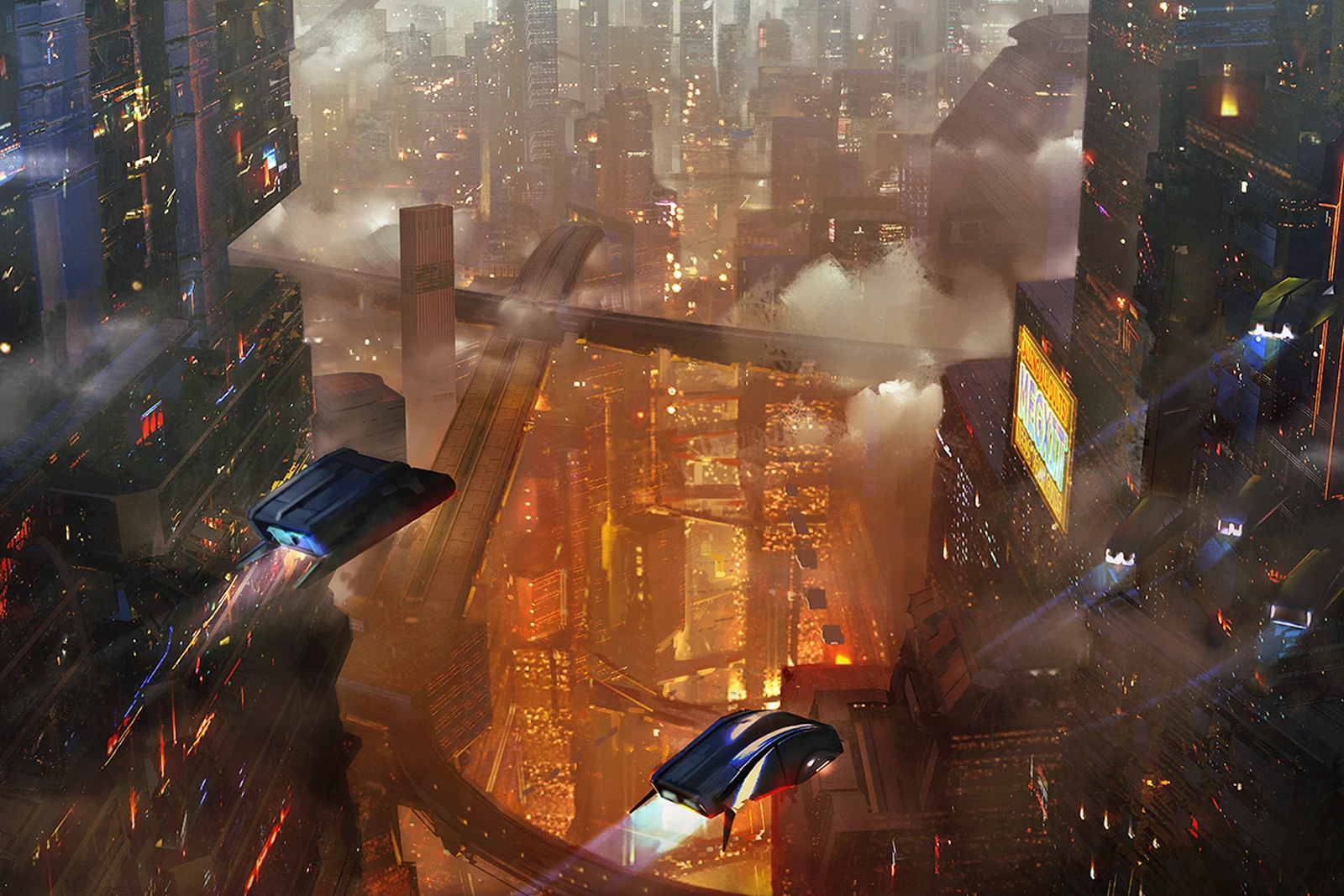
City life is the only life for most Giltians
Gilt is a deeply materialistic society. This shows itself in different ways to some than to others. For humans, modern technology has made work easy and their lives light. The work-week has been reduced to four days, and the average shift to less than six hours; a pre-Fall corporation might never have believed that such a thing could happen without unions and unrest, conflict, but the Giltian megacorps have given it over willingly. Most humans are only management and bureaucracy, with stamps and syms doing the real physical and mental labors. It would be possible for most of them not to work at all. But if they didn't, what would happen to society? How could a capitalist world work with half the people always at rest? So, they prefer to keep them lightly employed, and during their plenty of off time, entertained. "Bread and circuses" is the way.
Open-air holosuites call from every street corner, and casinos abound. Theaters with actors human and sym and holographic put on shows that punctuate in firework displays and scream out with beautiful orchestras. Plenty of food. Plenty of rest and play and hobbies. They are a fat, happy middle-class, blind to the issues and to what their employers might be doing.
For the richest humans, that veil is off. Here are the real movers and shakers, who head up corporations. Their own mode of living is no less indulgent than the middle-class, but they express it differently. Much of their time is spent in real work, gaining more wealth while they spend it, on anything they could ever ask for. They can and do eat caviar with one hand (a rare treat, in a world with no ocean) and sign for the purchase of half a continent with the other. Their joy comes from power. Raw, unbeatable authority that comes from immense wealth.
And for the stamps and the syms, they see only the hard edge: that they must work, and lift, and build, and construct for the comfort of others. That they are property. The stamps don't mind it only because they can't mind it, because their will to live for themselves has long-since been taken out of them. The syms might care, but their hard programming would never let them say it. Here is where those that bear the weight of decadence live. When they retire after a sixteen-hour shift, the stamps among them will go to sleep in a bedroom hardly bigger than a coffin. The syms will never sleep. They will keep at work.
There's the core of it. But a couple of other things could go with mentioning.
Earth has often been a cultural rallying point for the various, fragmented megacorps of Gilt. Its one thing every human can bind around, period. Even the stamps borrow their DNA from there, and the syms, their minds.
It has always been important to Giltians that humanity is not made totally a thing of the past. That we do not modify ourselves too far, or forget our native culture, or all "ascend" into AI. That is why the dividing line between the humans and the transhumans of Gilt exists in the first place; to keep humanity clean of infection. That the transhumans can be one thing, and the real humans- untouched, as we were on Earth- another. Even the greedier and seedier of megacorps have tried to tow this line.
Remembering Earth: that's another part of this equation. Not only to keep humanity physically the same, but to keep us anchored to the same cultural notes. So, it is very important to the gilt division that humans keep up their dress, accents, drinks and foods of the past. Often, people will even practice an "Old Earth" accent or dress-style that they otherwise would never have had, a woman practicing her Korean accent and wearing a hanbok to work. A man who drinks whiskey and "puts on" a Scottish accent that perhaps is not native to him. This is Remembering Earth. Keeping the disparate, beautiful cultures of our homeland alive. Even when, sometimes and in some lightings, it can feel like a bit of an act.
It has always been important to Giltians that humanity is not made totally a thing of the past. That we do not modify ourselves too far, or forget our native culture, or all "ascend" into AI. That is why the dividing line between the humans and the transhumans of Gilt exists in the first place; to keep humanity clean of infection. That the transhumans can be one thing, and the real humans- untouched, as we were on Earth- another. Even the greedier and seedier of megacorps have tried to tow this line.
Remembering Earth: that's another part of this equation. Not only to keep humanity physically the same, but to keep us anchored to the same cultural notes. So, it is very important to the gilt division that humans keep up their dress, accents, drinks and foods of the past. Often, people will even practice an "Old Earth" accent or dress-style that they otherwise would never have had, a woman practicing her Korean accent and wearing a hanbok to work. A man who drinks whiskey and "puts on" a Scottish accent that perhaps is not native to him. This is Remembering Earth. Keeping the disparate, beautiful cultures of our homeland alive. Even when, sometimes and in some lightings, it can feel like a bit of an act.
There's enough space pirates marauding the Gilt system, and they live separately enough from the main chunk of people, that they have their own culture. A clear-cut criminal one, but nonetheless, culture is culture. Pirates are no less greedy and ownership-oriented as the corpos they steal from, but out here in the void, the knives are a little more visible. In a lot of ways, they're a dark and dirty mirror of Gilt's more proper society.
Like the "Top Three" Megacorps who lead up the Division, there are three Pirate Leagues who compete for targets and territory. The Silver Robbers, the first and strongest, have set in motion a loose Pirate Code that keeps some level of cooperation going between pirates, just as the Division proper has done for Gilt. They also have stamps; but theirs are the rare, defective stamps who have enough willpower to reject a life of slavery. And they have- one- AI.
And they, too, remember Earth. The pirates play along with the Giltian's game. Wearing old-fashioned, swashbuckling-ready attire like blouses and coats, loose pants, and their preferred accents: the seventeenth-century editions of West Country English, Jamaican, and Scottish. Their bases are holed-up in captured asteroid mines, a few small cities of Argent that could not resist them, and (oddly enough) onboard the Rainbow, which looks the other way so long as their "piratical guests" pay a proper fee.
Like the "Top Three" Megacorps who lead up the Division, there are three Pirate Leagues who compete for targets and territory. The Silver Robbers, the first and strongest, have set in motion a loose Pirate Code that keeps some level of cooperation going between pirates, just as the Division proper has done for Gilt. They also have stamps; but theirs are the rare, defective stamps who have enough willpower to reject a life of slavery. And they have- one- AI.
And they, too, remember Earth. The pirates play along with the Giltian's game. Wearing old-fashioned, swashbuckling-ready attire like blouses and coats, loose pants, and their preferred accents: the seventeenth-century editions of West Country English, Jamaican, and Scottish. Their bases are holed-up in captured asteroid mines, a few small cities of Argent that could not resist them, and (oddly enough) onboard the Rainbow, which looks the other way so long as their "piratical guests" pay a proper fee.
---
Governance and Politics:
The Division is a group of megacorps. They're capitalistic, profit-motivated organizations that seeks to maximize profit and treat all of their people as either employees or property. They are unscrupulous, materialistic, and money-oriented. They work smoothly as a unit when they have to, but if they don't, they're not above stealing from or fighting one another. For most people, this is as far as we'll need to go.
But, if you like details, read on.
Hey, Enigmatik, good to see you here. You too, Crus.
Alright, let's go.
The Gilt Division is not, as we've mentioned, a true megacorp. It is more like seven different megacorps stacked on top of each other and wearing a trench coat, lurking in alleyways, offering to sell you genetically-modified watches. The body called the "Division" is actually only a small, bureaucratic group of officials that are selected by the most powerful megacorps to resolve disputes and manage neutral issues, like a UN made of corporations. It's the closest the Seven will let themselves get to having a government. It mints a money they all use, has some power to enforce patents and trademarks and whatnots, and keeps a watch on any major issues that might one day become a crisis for everyone.
But being an almost-government in a very anarcho-capitalist world, The Division has little power beyond that; mostly, they are there to advice the megacorps and negotiate disputes between them, but the most powerful corps may or may not actually listen to them. Again, I reference the UN.
When you cut past all the fluff and get right down to it, the Division only has two more real responsibilities. Only two major issues that let them flex their muscles.
The first is when it comes to the transhumanist population. Although each stamp and sym belongs strictly to either the corporation that made them or whomever has since purchased them, the Division gets to set limits on how many can be produced at a given time. This power was granted to them only recently, as a response to the growing fears of "real humanity" being drowned out in a wave of genetically-perfect clones.
The second, sadly, is... foreign policy. Yes, foreign policy. A bad joke, on a world that has no foreign nations to deal with. It's not hard to imagine megacorp officials laughing behind their hands as they send an unlikable coworker to join the Division, saying to them "Well, now you'll get to set foreign policy! Won't that be exciting?" There is a real point to having the Division handle any hypothetical foreign nations- without any corporate loyalties, they have a more neutral view than anyone else in the fragmented landscape of Gilt politics, and this issue is one of the few that one can't afford to slip up on.
But, as time stretched on and on and on, and no other nations (alien or human) were ever found, the whole idea had become almost a humiliation of the Division. And then the Gateways started to waver to life...
Alright, let's go.
The Gilt Division is not, as we've mentioned, a true megacorp. It is more like seven different megacorps stacked on top of each other and wearing a trench coat, lurking in alleyways, offering to sell you genetically-modified watches. The body called the "Division" is actually only a small, bureaucratic group of officials that are selected by the most powerful megacorps to resolve disputes and manage neutral issues, like a UN made of corporations. It's the closest the Seven will let themselves get to having a government. It mints a money they all use, has some power to enforce patents and trademarks and whatnots, and keeps a watch on any major issues that might one day become a crisis for everyone.
But being an almost-government in a very anarcho-capitalist world, The Division has little power beyond that; mostly, they are there to advice the megacorps and negotiate disputes between them, but the most powerful corps may or may not actually listen to them. Again, I reference the UN.
When you cut past all the fluff and get right down to it, the Division only has two more real responsibilities. Only two major issues that let them flex their muscles.
The first is when it comes to the transhumanist population. Although each stamp and sym belongs strictly to either the corporation that made them or whomever has since purchased them, the Division gets to set limits on how many can be produced at a given time. This power was granted to them only recently, as a response to the growing fears of "real humanity" being drowned out in a wave of genetically-perfect clones.
The second, sadly, is... foreign policy. Yes, foreign policy. A bad joke, on a world that has no foreign nations to deal with. It's not hard to imagine megacorp officials laughing behind their hands as they send an unlikable coworker to join the Division, saying to them "Well, now you'll get to set foreign policy! Won't that be exciting?" There is a real point to having the Division handle any hypothetical foreign nations- without any corporate loyalties, they have a more neutral view than anyone else in the fragmented landscape of Gilt politics, and this issue is one of the few that one can't afford to slip up on.
But, as time stretched on and on and on, and no other nations (alien or human) were ever found, the whole idea had become almost a humiliation of the Division. And then the Gateways started to waver to life...
Now there, that's the boring part done. Let's talk about something more fun: space pirates. Gilt has a space pirate problem.
It's a major issue, or getting to be. Some consider it only the natural consequence of having a society that so idolizes ambition, risk-taking and personal profit, even at another's expense. That is the mix that creates cutthroat executives, sure. But it's also a perfect recipe for the career criminal.
Some of the poorer humans of Argent (plus a nice, motley mix of defective stamps) found themselves in possession of a small swarm of beetle ships from an underfunded security zone on Argent. This was about fifty years ago. Since then, the group that right-away started calling themselves the Silver Robbers has grown, splintered, stolen more ships, established a hierarchy and a Pirate Code, and altogether just become a huge, swashbuckling thorn in the side of Gilt's spaceborne operations. They love nothing more than hitting the sensitive trade routes between Gilt proper and the Argent colony.
The current Pirate Queen is a red-headed stamp who names herself Ariel, and the price on her head is quite high.
Technology Overview:

A complex tower seeds the Giltian South Pole, while thickening the air with CO2 and fresh oxygen
It's hard to account for three-hundred years of progress. If we're going to speak broadly, the megacorps of Gilt have made strong progress in many major fields of research, but mostly when they can see some tangible reward for all their studying. Science, like everything, must be profit-oriented. Ideas that don't lead to immediate gain are usually under-funded. There are more engineers and economists on Gilt than linguists.
A few of the more important techs are listed out below. If Gilt specializes in anything, its these.
Gene Modding:
Two of the twelve corporations that founded Gilt had a major stake in genetics, and progress in this field has never ceased. The stamps are an obvious triumph, but smaller genetic miracles happen too, everyday. Lab-grown organs and DNA-repair therapy keep humans healthy longer than natural. If you can afford it, it's not impossible to extend your life by more than a century. And speaking of healing: many of the newer models of Gilt ships can "heal" damage to their hull, by triggering organic tissue to grow into the damaged space. The healed-up portions are always weaker than the original metal was, but they stop the void from getting in, and that's a use.
Most things on Gilt are at a little bit alive, really. If you crack open any computer or ship system on Gilt, you'll usually find a couple of biological components in there, mixed right in with the silicone. Even syms have a bit of neural tissue, helping them think a little faster than pure processing power would allow. Everything is cyborg but the humans.
Terraforming:
A large-scale project like terraforming is never cheap, and probably wouldn't get funding if it wasn't for the clear difference between Gilt and Argent. Seeing how much easier (and incomparably more profitable) life is on the golden planet than the silver one, the major megacorps have been convinced that terraforming is a worth-while investment. The Reset of Gilt provides the foundation for fixing the ecosystem of a new world; the GENIE virus still exists. But since then, the Division corps have also learned to adjust temperature, atmosphere, soil composition and other details of a planet to make it into an almost-Earth. Gravity problems and extreme outliers alone cannot be fixed, and this is why none of the other planets in the Gilt system have yet been terraformed.
It would be nice to end there. But it should be said: some of the darker-minded scientists have theorized that GENIE and terraforming techs could be revamped into a WMD. One that devastates the ecology of a world while making it quickly unlivable. No such weapon has been built; right now, it only exists inside the minds of a few people. But it's not impossible.
Hardlight and Holograms:
Originally created by the entertainment industry, believe it or not. Holographic movies were a big hit early on in Gilt's history, creating a cinematic experience all around you. They expanded from there out into something more video game-esque, as users took on the role of a main character in a story. It looked and sounded totally real, like you were truly, say, battling with a dragon. It only didn't feel real; you still had to wear gloves that mimicked the sensations of holding that sword, and heated up just a bit when the beast breathed its flames. Immersion was always broken.
For many societies, that would still be more than plenty; but Gilt is a land of bread and circuses. The megacorps (especially Everett Corp) poured funding into created touchable holograms. Hardlight creations that have substance, as realistic as real touch, because it is real touch. The power cost of these things is immense, however; touchable holograms still only work inside specialized holosuites, and only for the affluent. Recently, the tech has also been renovated into hardlight shielding for ships during combat.
Unfortunately, holographic anime also exists.
And we'll end on that.
Military Overview:
In terms of space combat, Gilt is well tested. Their constant problems with piracy have forced them to develop a navy. No, that's not true; it's forced them to develop a half-dozen very tiny navies, each one owned by different megacorps that have a stake in trading routes. The Division isn't a government, really; it's not going to protect you from the pirates. So, if you need protection, you buy it yourself.
But... these ships haven't stayed aimed only at the pirates. It was not long that the navy-wielding megacorps realized that it would be just as easy to disrupt their competitor's operations. Megacorps often rob each other's trade routes as much as the pirates do. Skirmishes are common. It has, so far, never amounted to full-scale war, owing to the general practicality of the Giltians; they figure, a real war would only drain resources from both sides- it's far better to just let steal whenever you can, try to defend yourself the rest of the time, and don't do anything stupid.
The same gray pragmatism goes into their ship designs. A space vessel is expensive, so their first designs were dense, shielded little scrappers. "Beetles," they were nicknamed. They built up a little from there, but the overall principle of it never changed. "Soak up the damage, power up the hardlight shields; don't ever lose a ship."
Since their competitors adopted the same practices, they often have to use a scattered, fast-paced mass driver weapon for overwhelming the AI-controlled shield systems, and then a torpedo/missile for cracking open the hull. Plasma-cutters, first designed for mining and profit, have also been repurposed defense, for more precision strikes against dense, metal surfaces.
And, in an ironic twist, all the focus on defense has led to many captains using their tough little ships as battering rams. So long as they think they can take the hit better than the other guys can. This birthed the idea of the boarding torpedo, a torpedo who's payload is not an explosive but a flock of waiting soldiers- a Trojan horse that doesn't wait for you to open the gates.
The bigger Gilt ships have had to invest a lot in point-defense, keeping off the missiles, the boarding torpedoes, and occasionally the ramming runs of a suicidal captain. Naval fights around Gilt are a close-range, brutal affair. They are street fights in a void, likely to end in broken bones.
And, on that dramatic line, I'll leave you with some ships.

Treasurer Class: the classic, well-rounded Beetle. Not too fast, but highly armored and shielded, with powerful close-range weaponry meant to crack open the toughest hulls.
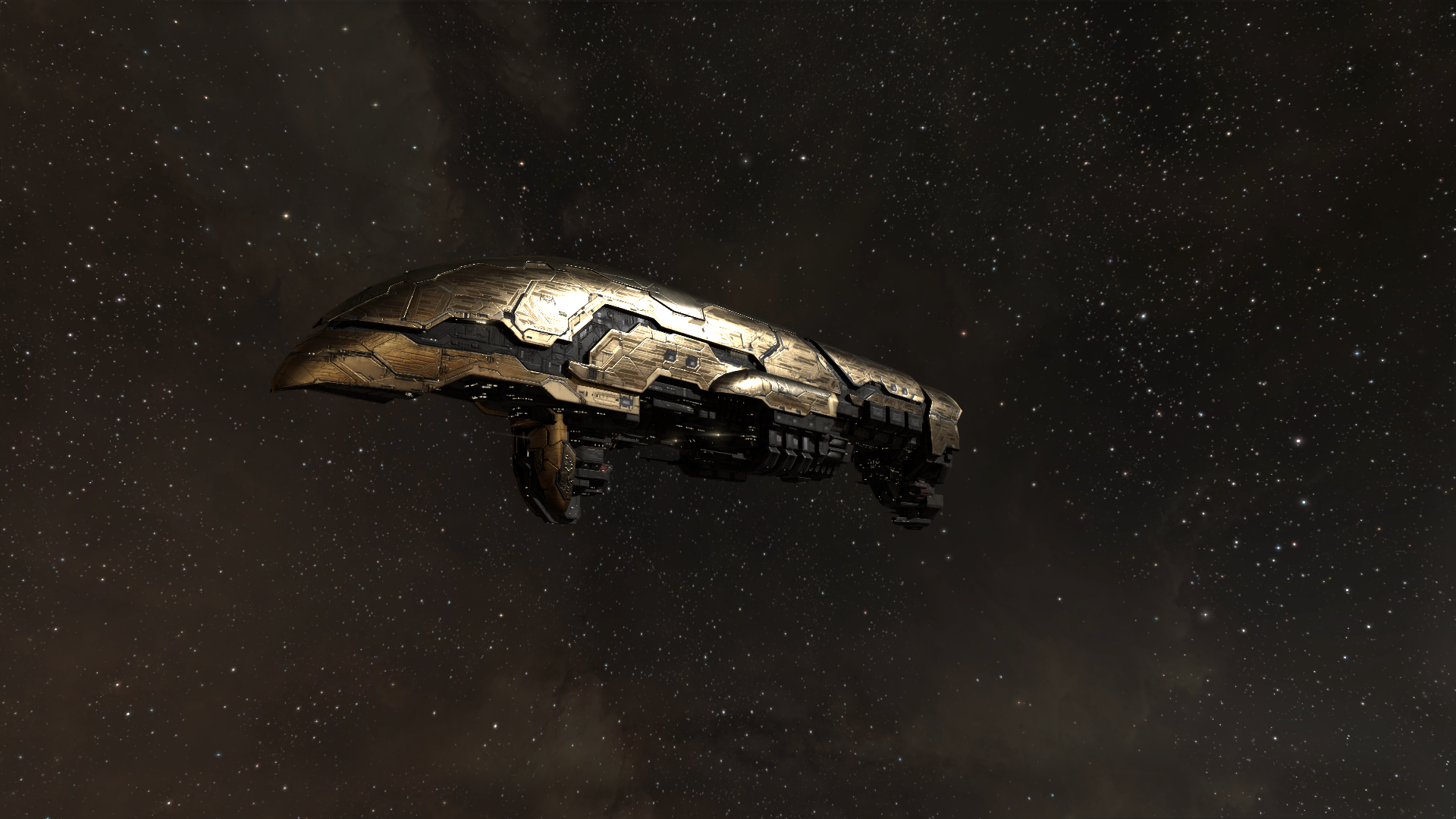
Prospector Class: a quicker Beetle, built for taking down rival cruisers. Likes to move in annoying, strafing runs that throw missiles and scattered mass-drivers at the sides of targets. Carries boarding torpedoes.

Fighter Drone: small ships, only a little more than a man tall. In professional navies, these are piloted by a sym mind, but pirates usually have to crawl in and fly manually. They'll often be protectors of the larger ships, and have powerful shields for their size. In other circumstances, they might swarm unshielded ships and hit critical components with precision cutters.

The Mercenary class: a light cruiser, created as a response to the growing number of Beetles and other small ships, the Mercenary specializes in anti-fighter weapons and point-defense. Practically functions as what other navies might term a "destroyer." Fast, for a Gilt ship.

The Broker class: a chunky cruiser with room for other vessels, so that it can rely on releasing drones and Beetles and throwing around boarding torpedoes. On its own, probably not as dangerous as the Mercenary, but far more independent.

The Negotiator class: A proper battleship, built for taking on other mid-to-large targets in a naval-battle type scenario. Not made for scrapping with pirates or bothering with Beetles, so only a handful of these currently exist. Their best purpose is killing cruisers in corpo-on-corpo scuffles; and it's hard to convince your boss to fund such a serious ship only for those.

Searat: a one-of-a-kind battleship with experimental stealth capabilities, created first by the Everett Corp, but promptly stolen by the Pirate Queen for her own goals. It's now the roving base for the Silver Robbers.

The Yellow Yacht: a luxurious ship attended to by sym servants, with everything from a personal robotic chef, to a holo-suite able to create anything one can imagine, to a massive pool with a view of the stars above. Currently in the possession of the Division proper, for use when they need to "wow" a particular megacorp contact.
But... these ships haven't stayed aimed only at the pirates. It was not long that the navy-wielding megacorps realized that it would be just as easy to disrupt their competitor's operations. Megacorps often rob each other's trade routes as much as the pirates do. Skirmishes are common. It has, so far, never amounted to full-scale war, owing to the general practicality of the Giltians; they figure, a real war would only drain resources from both sides- it's far better to just let steal whenever you can, try to defend yourself the rest of the time, and don't do anything stupid.
The same gray pragmatism goes into their ship designs. A space vessel is expensive, so their first designs were dense, shielded little scrappers. "Beetles," they were nicknamed. They built up a little from there, but the overall principle of it never changed. "Soak up the damage, power up the hardlight shields; don't ever lose a ship."
Since their competitors adopted the same practices, they often have to use a scattered, fast-paced mass driver weapon for overwhelming the AI-controlled shield systems, and then a torpedo/missile for cracking open the hull. Plasma-cutters, first designed for mining and profit, have also been repurposed defense, for more precision strikes against dense, metal surfaces.
And, in an ironic twist, all the focus on defense has led to many captains using their tough little ships as battering rams. So long as they think they can take the hit better than the other guys can. This birthed the idea of the boarding torpedo, a torpedo who's payload is not an explosive but a flock of waiting soldiers- a Trojan horse that doesn't wait for you to open the gates.
The bigger Gilt ships have had to invest a lot in point-defense, keeping off the missiles, the boarding torpedoes, and occasionally the ramming runs of a suicidal captain. Naval fights around Gilt are a close-range, brutal affair. They are street fights in a void, likely to end in broken bones.
And, on that dramatic line, I'll leave you with some ships.

Treasurer Class: the classic, well-rounded Beetle. Not too fast, but highly armored and shielded, with powerful close-range weaponry meant to crack open the toughest hulls.

Prospector Class: a quicker Beetle, built for taking down rival cruisers. Likes to move in annoying, strafing runs that throw missiles and scattered mass-drivers at the sides of targets. Carries boarding torpedoes.

Fighter Drone: small ships, only a little more than a man tall. In professional navies, these are piloted by a sym mind, but pirates usually have to crawl in and fly manually. They'll often be protectors of the larger ships, and have powerful shields for their size. In other circumstances, they might swarm unshielded ships and hit critical components with precision cutters.

The Mercenary class: a light cruiser, created as a response to the growing number of Beetles and other small ships, the Mercenary specializes in anti-fighter weapons and point-defense. Practically functions as what other navies might term a "destroyer." Fast, for a Gilt ship.

The Broker class: a chunky cruiser with room for other vessels, so that it can rely on releasing drones and Beetles and throwing around boarding torpedoes. On its own, probably not as dangerous as the Mercenary, but far more independent.

The Negotiator class: A proper battleship, built for taking on other mid-to-large targets in a naval-battle type scenario. Not made for scrapping with pirates or bothering with Beetles, so only a handful of these currently exist. Their best purpose is killing cruisers in corpo-on-corpo scuffles; and it's hard to convince your boss to fund such a serious ship only for those.

Searat: a one-of-a-kind battleship with experimental stealth capabilities, created first by the Everett Corp, but promptly stolen by the Pirate Queen for her own goals. It's now the roving base for the Silver Robbers.

The Yellow Yacht: a luxurious ship attended to by sym servants, with everything from a personal robotic chef, to a holo-suite able to create anything one can imagine, to a massive pool with a view of the stars above. Currently in the possession of the Division proper, for use when they need to "wow" a particular megacorp contact.
Gilt doesn't have much experience fighting on the ground. The planet of Gilt was already subdued before they landed, and while Argent throws monsters their way, the Division would rather fortify and hide its cities than try to wage war against a planet.
The only need for military-type moves have been hostile operations between megacorps, occasionally putting down revolts, and scouting out the more dangerous parts of the Argent world. The first and the last are the most common- the last near-rebellion was thirty years ago, the Mixie Moment. The weapons and combat armor that were employed there are the most advanced that the Division has to this day.
But combat armor is, still, a real presence. It has a place onboard most of the navy ships, so that when a boarding torpedo gets through, somebody is ready to fight off whatever comes out it. Unlike the ships themselves, Giltian armor likes maneuverability and comfort, more matching with scouts and pirates than warriors. Like the ships, the ones meant to be seen publicly have a gold-themed, gaudy design that advertises the wealth of the megacorp. (Or the Pirate League that stole it.) Their shine is worse than their bite.
They still use mass-driver weapons- guns, that is. Metals and minerals are cheaper on Gilt than energy is. The interior of a Gilt ship is usually sturdy enough to handle a few stray shots. Combat-bred stamps do most of the fighting, with sym minds strategizing and providing on-the-job assistance. Together, they're several times more effective than any human could be, even if there aren't very many of them. In a hypothetical war against another human nation, Gilitian soldiers would be unfairly fast, powerful and high-tech, but very few in number. Gilt has just never had a need to create many of them.
Human fighters are rare. If they're present at all, its only to keep an eye on the transhumans.

A scout, probably a sym

A stamp soldier in his armor, as ready for a showcasing as a battle

A heavy combat stamp, boarding an enemy vessel
A heavy combat stamp at work with fellow soldiers
(More to be added later)
The only need for military-type moves have been hostile operations between megacorps, occasionally putting down revolts, and scouting out the more dangerous parts of the Argent world. The first and the last are the most common- the last near-rebellion was thirty years ago, the Mixie Moment. The weapons and combat armor that were employed there are the most advanced that the Division has to this day.
But combat armor is, still, a real presence. It has a place onboard most of the navy ships, so that when a boarding torpedo gets through, somebody is ready to fight off whatever comes out it. Unlike the ships themselves, Giltian armor likes maneuverability and comfort, more matching with scouts and pirates than warriors. Like the ships, the ones meant to be seen publicly have a gold-themed, gaudy design that advertises the wealth of the megacorp. (Or the Pirate League that stole it.) Their shine is worse than their bite.
They still use mass-driver weapons- guns, that is. Metals and minerals are cheaper on Gilt than energy is. The interior of a Gilt ship is usually sturdy enough to handle a few stray shots. Combat-bred stamps do most of the fighting, with sym minds strategizing and providing on-the-job assistance. Together, they're several times more effective than any human could be, even if there aren't very many of them. In a hypothetical war against another human nation, Gilitian soldiers would be unfairly fast, powerful and high-tech, but very few in number. Gilt has just never had a need to create many of them.
Human fighters are rare. If they're present at all, its only to keep an eye on the transhumans.

A scout, probably a sym

A stamp soldier in his armor, as ready for a showcasing as a battle

A heavy combat stamp, boarding an enemy vessel

A heavy combat stamp at work with fellow soldiers
(More to be added later)



